Programming in (M)ASM x64 bit
#Programming #Assembly #Windows (2023-08-16)
WHY?
(If you are masochists like I am and take pleasure in writing some ASM.) If you are interested in shellcoding and similar stuff,you probably would have found a bunch of tutorials for shellcoding in linux using NASM or [REDACTED] assemblers . I tried to learn ASM for windows and could not really find many posts out there that had what I needed . So here is my effor to fill the blank. Lets try to write some really simple code in Assembly language and compile it with the help of MASM. MASM ,as mentioned by official MSDN , is The Microsoft Macro Assembler. I higly suggest reading more about it (https://learn.microsoft.com/en-us/cpp/assembler/masm/microsoft-macro-assembler-reference?view=msvc-170)
**We are not going to look at inline assembly in this post . We are going to write in pure MASM
Setup: Visual Studio
There are different better ways of doing this but for the sake of
simplicity we’ll be using Visual Studio community
edition(https://visualstudio.microsoft.com/vs/) . Next,make sure to
install the C/C++ modules 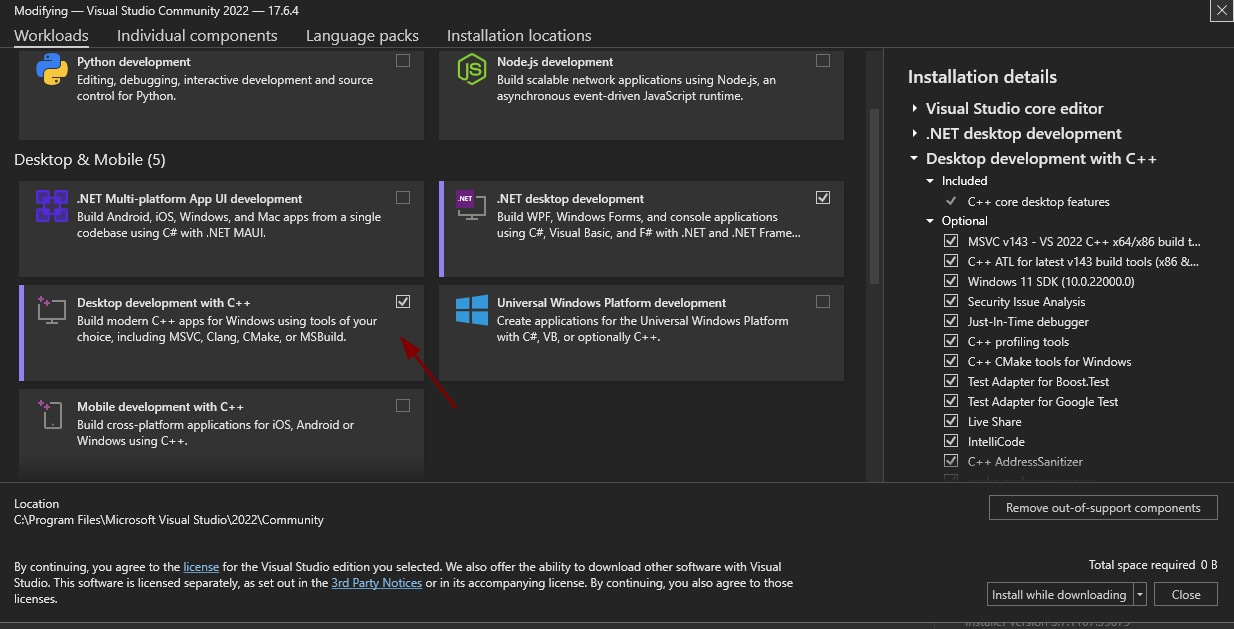 Now we can start by
creating a new project. Select Empty Project and Create a new
project
Now we can start by
creating a new project. Select Empty Project and Create a new
project
 Once our project is
created, click on
Once our project is
created, click on
Build Dependencies -> Build Customizations and check
masm . Choose OK to save the selection. 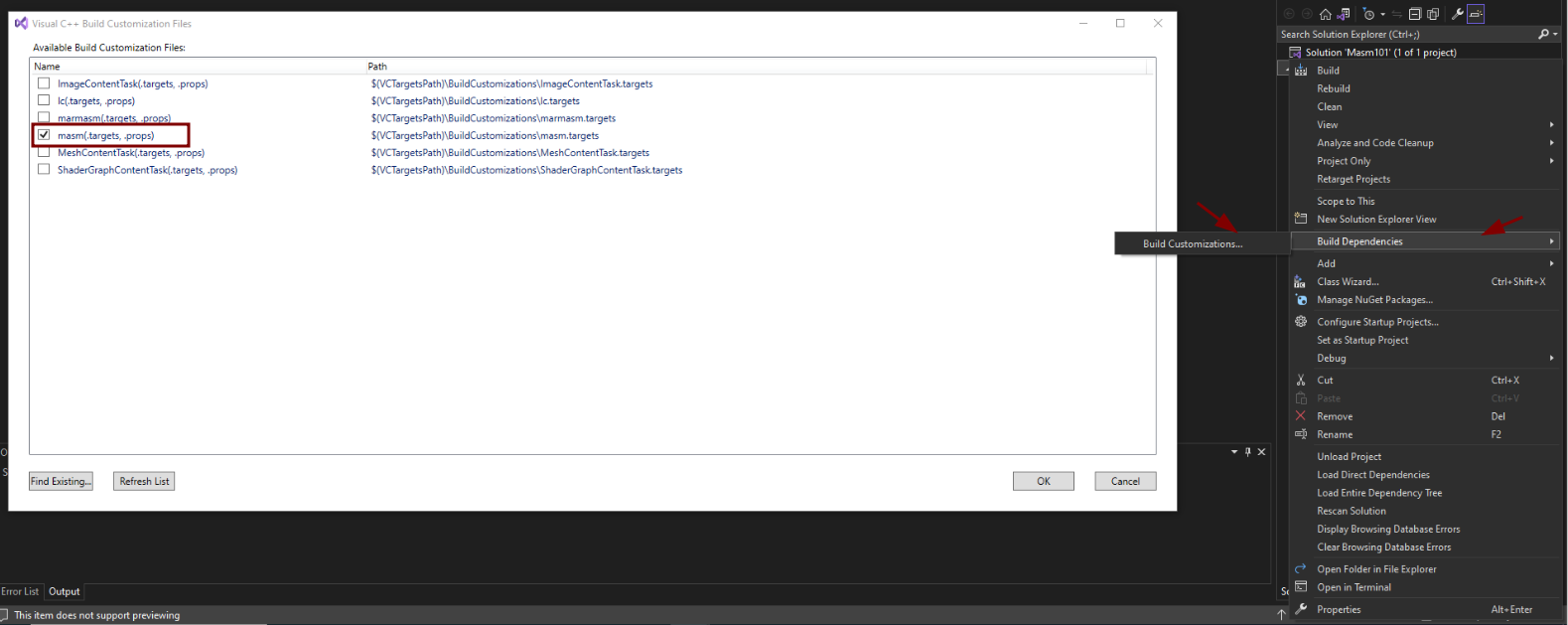
next we add a new Item to our project . To do so right click on the
project and select Add -> New Item -> Func.asm 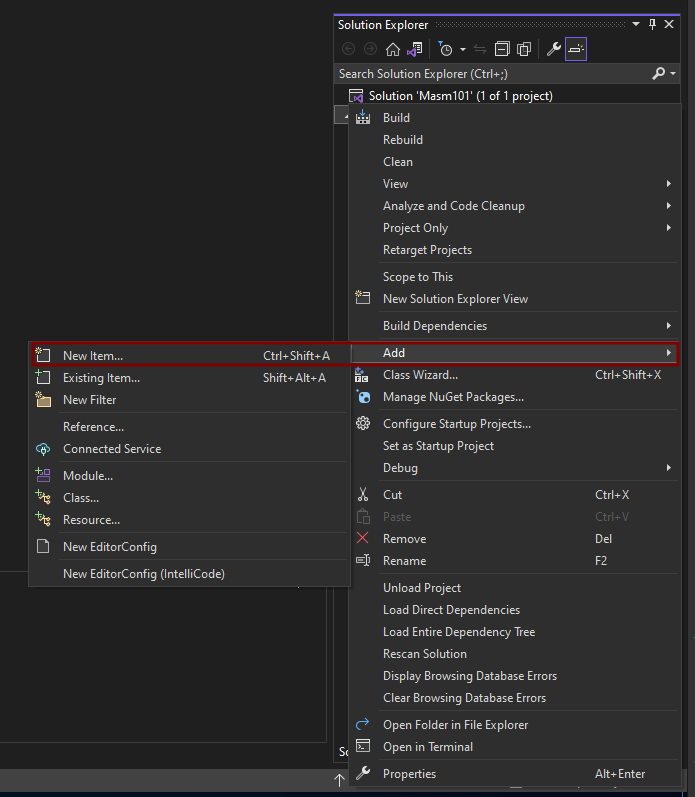 Now all that is left
is to make this file be recognizable as an Assembly code . To do so
Now all that is left
is to make this file be recognizable as an Assembly code . To do so
Func.asm->Properties -> Item Type -> Microsoft Macro Assembler -> Ok
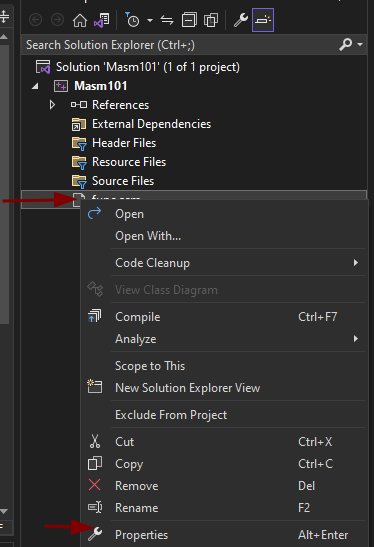
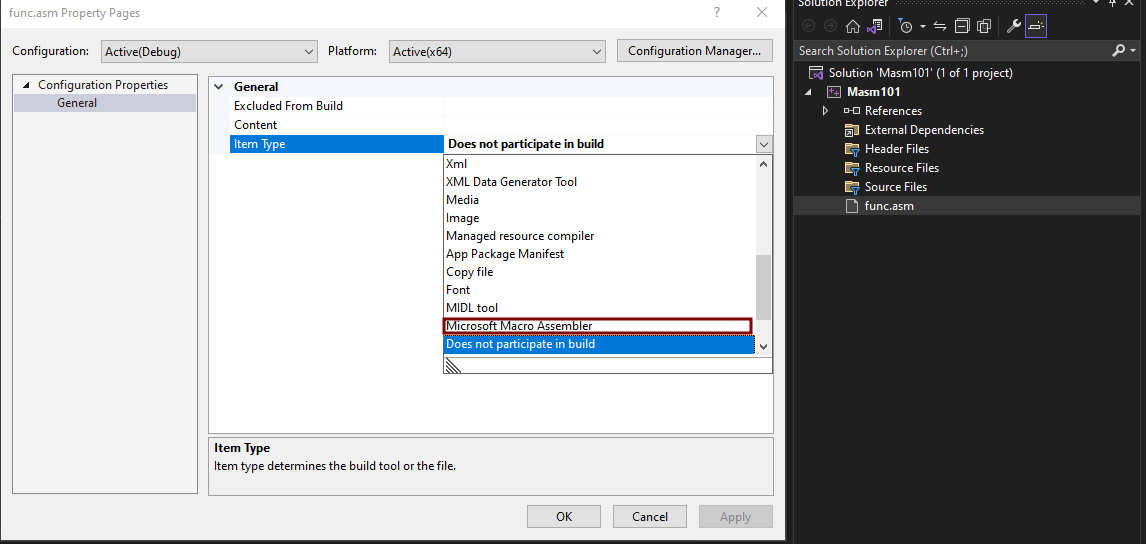
One Final thing to set is the entry point in the linker .
right click project -> Properties -> linker->EntryPoint->Main
**Main is the Procedure we are using in our assembly code 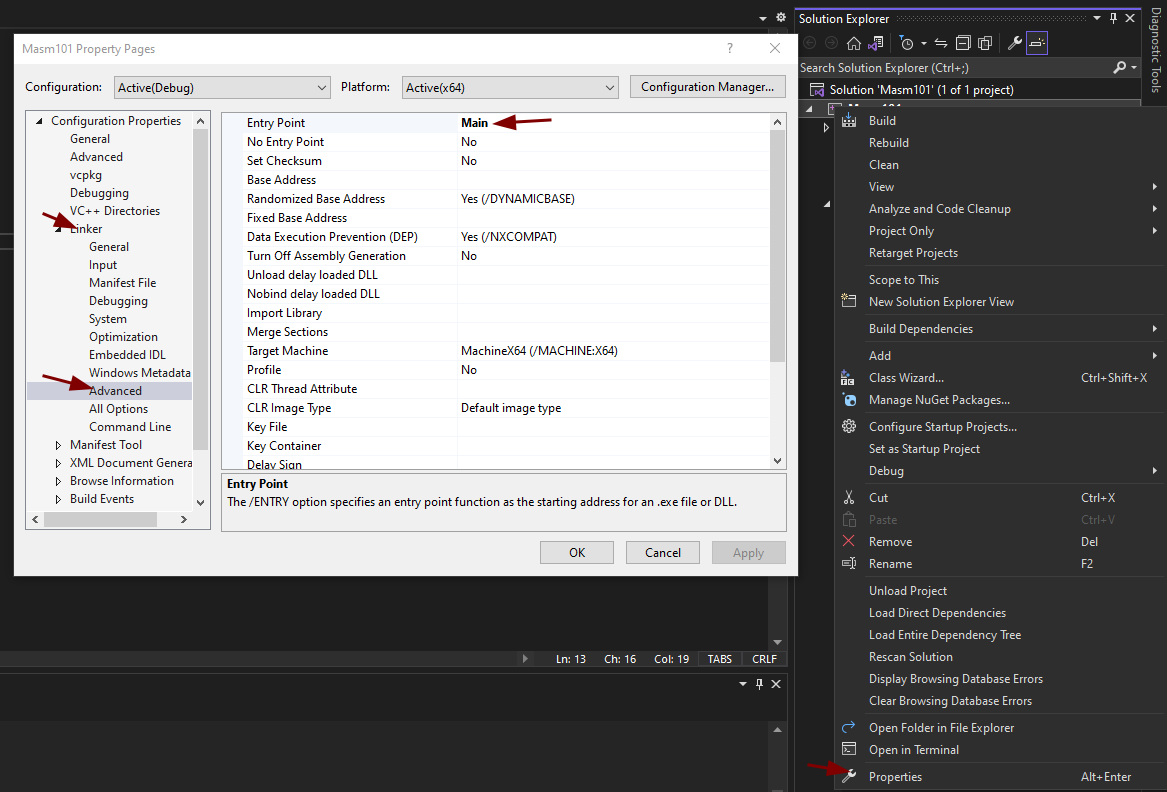
We are done with the setup ### Code According to the gods of Windows ,the first program must always be popping a MessageBox . Lets follow the ritual
extern MessageBoxA : proc ; extern the messagebox procedure
.data ; start of .data section
text db "Hello",0
Caption db "World",0
.code
Main proc
; allocate stack frame of size 8 bytes
sub rsp,8
;Following x64 Calling convention as dictated by MSDN.
xor rcx,rcx ; First argument of the function MessageBoxA . The value is 0
lea rdx,text ; Second argument which loads the value of the variable 'data'
lea r8,Caption ; Third argument which loads the value of the variable 'db'
xor r9d,r9d ; Fourth argument . The value is 0
call MessageBoxA ; Call to the MessageBox Function .
add rsp,8
ret
Main endp
endThe comments in the code should be pretty self explanatory. run the
code and you should see a neat MessageBox popping .  The code is working
as expected . But lets take a bit deeper look . Let start with the first
line , what does it exactly mean and why have we used it?
The code is working
as expected . But lets take a bit deeper look . Let start with the first
line , what does it exactly mean and why have we used it?
extern MessageBoxA : proc This line tells the MASM that our
code is referencing to an external procedure(A procedure is like a
function)called MessageBoxA . You can compare it with something like
#include Headername in C or import os in
python . To make our life easier , we simply use the Procedure that’s
already included . we do not need to do any fancy syscalls ,like we do
in Linux ,YET!!! .
Data Section
.data The data section is where our initialized static
variables are defined . We define two variables each with size of a byte
. DB : define byte
Code Section
.code The code section is where our executable code
resides.
We begin the procedure with the directive Main proc and
we end the procedure with Main endp . Any procedure you
want to implement needs to have a name proc syntax and it
must end with name endp . And wrap up the entire code with
the end directive.
The sub rsp,8 allocates 8 bytes of space on the stack as
our stack frame needs to be big enough. Refer to
https://stackoverflow.com/questions/3699283/what-is-stack-frame-in-assembly
if you are not aware of what a stack frame is.
we only need 8 bytes because we have no local variables or non volatile registers . the only thing that needs some space is the Function CALL which pushes the Return address onto the stack when the function is called.
Note that ,in x64 assembly, by default a 32bytes(20h) shadow space is allocated to the stack above the return address to align the stack . If we are passing the arguments using registers only like in the above case we do not need to worry about allocating more space .
MASM for 64 bit follows x64 Calling Convention which requires you to pass the first argument in rcx,2nd in rdx,3rd in r8 and 4th in r9.
What IF my Func has more than 4 ARGS????
The MessageBoxA only has 4
arguments(int MessageBoxA([in, optional] HWND hWnd, [in, optional] LPCSTR lpText, [in, optional] LPCSTR lpCaption, [in] UINT uType),so
it was convenient for us to use the 4 registers . But what if there are
more arguments , say,the CreateFileA
(HANDLE CreateFileA([in] LPCSTR lpFileName, [in] DWORD dwDesiredAccess, [in] DWORD dwShareMode, [in, optional] LPSECURITY_ATTRIBUTES lpSecurityAttributes, [in] DWORD dwCreationDisposition, [in] DWORD dwFlagsAndAttributes, [in, optional] HANDLE hTemplateFile)
Function requires more than 4 arguments . How would we pass the other
arguments? MSDN states that we push the rest of the arguments onto the
stack in reverse order.
Lets look at the code below that creates a file called
Temp.txt
**extern CreateFileA : proc
GENERIC_READ equ 080000000h
GENERIC_WRITE equ 040000000h
FILE_ATTRIBUTE_NORMAL equ 080h
CREATE_ALWAYS equ 4
.data
Filename db "Temp.txt",0
.code
Main proc
sub rsp,40h
mov rcx,OFFSET Filename ; 1st arg
mov rdx,GENERIC_READ or GENERIC_WRITE ;2nd arg
xor r8,r8 ; 3rd arg
xor r9,r9 ; 4th arg
mov qword ptr [rsp+30h],0 ; 7th (addr = 48)
mov qword ptr [rsp+28h],FILE_ATTRIBUTE_NORMAL ; 6th arg (addr = 40)
mov qword ptr [rsp+20h],CREATE_ALWAYS ; 5th (addr = 32)
call CreateFileA
add rsp,40h
ret
Main endp
end 
It works as intended. Lets break down the code from the
mov qword ptr [rsp+30h],0 instruction as it looks kinda
confusing . why are we moving the 7th argument onto the stack ? Didn’t
we mention before that MSDN states that we PUSH the
aguments onto the stack ? Then why are we MOVING it onto
the stack?
Lets take a step back and draw the stack from its base . Step 1 : The Stack is empty initially
Step 2 : The Main Procedure is called and we allocate 40h (64 bytes) of space for our stack frame . So Our stack looks somewhat like this.
 To get a
sense of practicality, Lets open x64 dbg and see the same .
To get a
sense of practicality, Lets open x64 dbg and see the same .
000000EE1CDBF748 (lets call base addr)was the base and
after we allocated 40h we are the address
000000EE1CDBF708 (lets call this Main addr) . This entire
operation was done by the assembly code sub rsp,40h 
Step 3: We passed the 4 arguments using registers and then we moved
the 7th argument onto the stack . The Below image outlines the values of
the registers . These operations were done by the assembly instructions
mov rcx,OFFSET Filename ; 1st arg mov rdx,GENERIC_READ or GENERIC_WRITE ;2nd arg xor r8,r8 ; 3rd arg xor r9,r9 ; 4th arg
 Now lets move
the 7th argument . The stack now looks like this. We moved the value 0
to
Now lets move
the 7th argument . The stack now looks like this. We moved the value 0
to rsp+30h position . If we calculate
000000EE1CDBF708+30h we get to the address
EE 1CDB F738 which is exactly where our stack is at and it
has the value 0 stored in it . Notice that the value is stored at
location which is closest to 000000EE1CDBF748 (Base addr) .
This operation was done by the assembly code
mov qword ptr [rsp+30h],0 
Step 4: Lets pace up and mov the other values onto the stack  We see the values
4,80 and 0 on the stack respectively and if you have noticed ,the values
are above each other . Which means they are
We see the values
4,80 and 0 on the stack respectively and if you have noticed ,the values
are above each other . Which means they are PUSHED onto the
stack . And if you are wondering why they are pushed in the following
way . This is quoted from MASM32.com “Parameter order on stack. The
Pascal order means that the first parameter has the highest address on
the stack and the last parameter has the lowest address, immediately
above the return address. If parameters are put on the stack by push
instructions then the first parameter is pushed first because the stack
grows downwards. The C order is opposite: The first parameter has the
lowest address, immediately above the return address, and the last
parameter has the highest address. This method was introduced with the C
language in order to make it possible to call a function with a variable
number of parameters, such as printf. Each parameter must take a whole
number of stack entries. If a parameter is smaller than the stack word
size then the rest of that stack entry is unused. Likewise, if a
parameter is transferred in a register that is too big, then the rest of
that register is unused.If the type of a parameter is not specified
explicitly because the function has no prototype or”
and lastly the function call to CreateFileA is called and we
deallocate the stack space with the instruction add rsp,40h
. This is what the stack looks at the end

You might be wondering about the empty space below and above the arguments in the stack , it is because those are simply the placeholders if we were to push the rest of the arguments onto the stack.
I’d would highly suggest writing some simple ASM code to truly understand it.